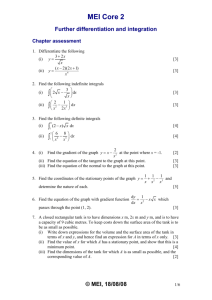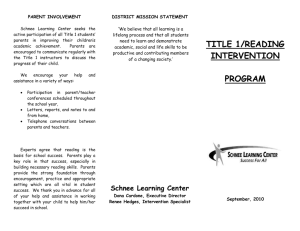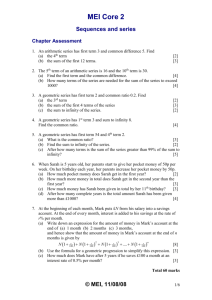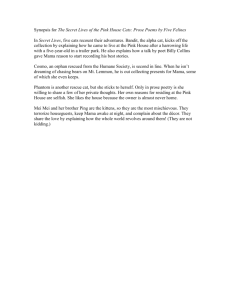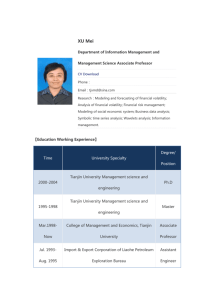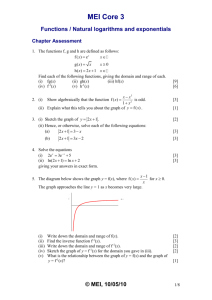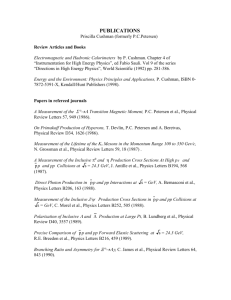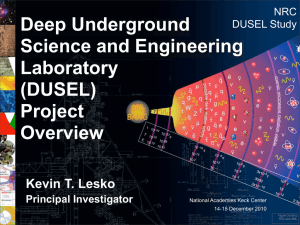WBS
advertisement
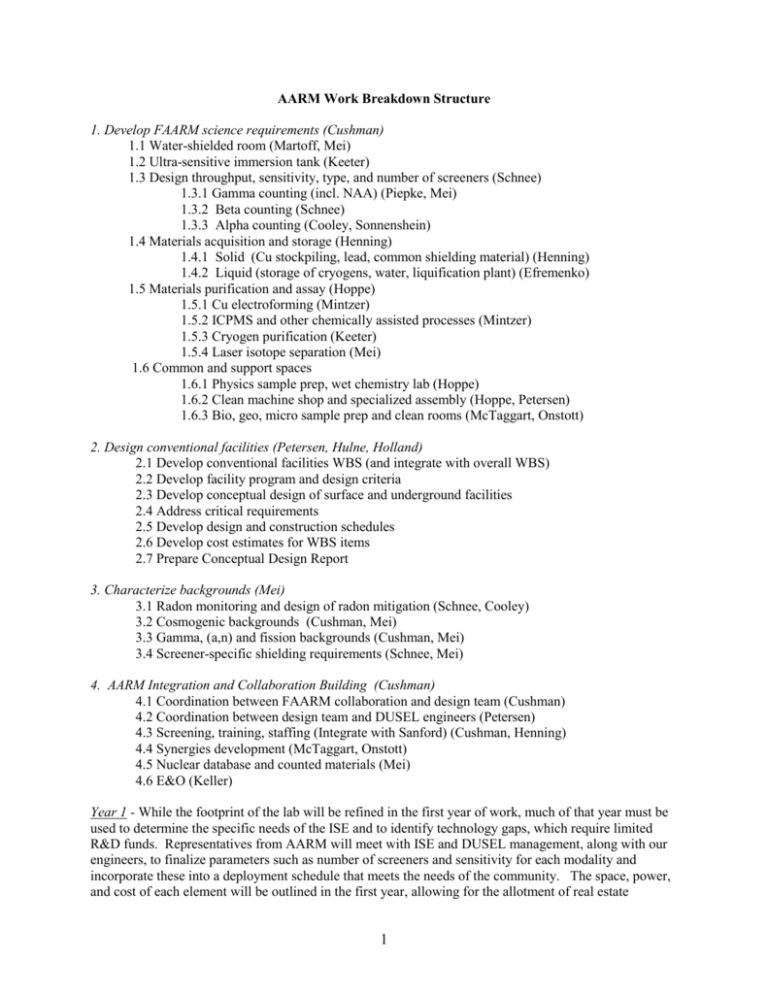
AARM Work Breakdown Structure 1. Develop FAARM science requirements (Cushman) 1.1 Water-shielded room (Martoff, Mei) 1.2 Ultra-sensitive immersion tank (Keeter) 1.3 Design throughput, sensitivity, type, and number of screeners (Schnee) 1.3.1 Gamma counting (incl. NAA) (Piepke, Mei) 1.3.2 Beta counting (Schnee) 1.3.3 Alpha counting (Cooley, Sonnenshein) 1.4 Materials acquisition and storage (Henning) 1.4.1 Solid (Cu stockpiling, lead, common shielding material) (Henning) 1.4.2 Liquid (storage of cryogens, water, liquification plant) (Efremenko) 1.5 Materials purification and assay (Hoppe) 1.5.1 Cu electroforming (Mintzer) 1.5.2 ICPMS and other chemically assisted processes (Mintzer) 1.5.3 Cryogen purification (Keeter) 1.5.4 Laser isotope separation (Mei) 1.6 Common and support spaces 1.6.1 Physics sample prep, wet chemistry lab (Hoppe) 1.6.2 Clean machine shop and specialized assembly (Hoppe, Petersen) 1.6.3 Bio, geo, micro sample prep and clean rooms (McTaggart, Onstott) 2. Design conventional facilities (Petersen, Hulne, Holland) 2.1 Develop conventional facilities WBS (and integrate with overall WBS) 2.2 Develop facility program and design criteria 2.3 Develop conceptual design of surface and underground facilities 2.4 Address critical requirements 2.5 Develop design and construction schedules 2.6 Develop cost estimates for WBS items 2.7 Prepare Conceptual Design Report 3. Characterize backgrounds (Mei) 3.1 Radon monitoring and design of radon mitigation (Schnee, Cooley) 3.2 Cosmogenic backgrounds (Cushman, Mei) 3.3 Gamma, (a,n) and fission backgrounds (Cushman, Mei) 3.4 Screener-specific shielding requirements (Schnee, Mei) 4. AARM Integration and Collaboration Building (Cushman) 4.1 Coordination between FAARM collaboration and design team (Cushman) 4.2 Coordination between design team and DUSEL engineers (Petersen) 4.3 Screening, training, staffing (Integrate with Sanford) (Cushman, Henning) 4.4 Synergies development (McTaggart, Onstott) 4.5 Nuclear database and counted materials (Mei) 4.6 E&O (Keller) Year 1 - While the footprint of the lab will be refined in the first year of work, much of that year must be used to determine the specific needs of the ISE and to identify technology gaps, which require limited R&D funds. Representatives from AARM will meet with ISE and DUSEL management, along with our engineers, to finalize parameters such as number of screeners and sensitivity for each modality and incorporate these into a deployment schedule that meets the needs of the community. The space, power, and cost of each element will be outlined in the first year, allowing for the allotment of real estate 1 between groups and setting of construction priorities. This information must be incorporated by CNA and associates to create an S5 project plan. Such work is intensely cooperative and will require resources for virtual and face-to-face meetings, including administrative resources and travel money. A major element of the first year will be the characterization of the backgrounds throughout the site. Once radon levels and seasonal variations have been determined, work can begin on radon mitigation plans, which may include simple ventilation plans or more ambitious radon removal systems similar to NEMO at Frejus. This characterization provides an opportunity for South Dakota and Minnesota undergraduate physics students, who will help with these measurements. This is part of our education and outreach efforts and students and faculty will participate in the PAN-Underground workshop planned for western South Dakota. We will present a paper at the South Dakota Science and Mathematics Teachers workshop regarding the opportunities for teachers at DUSEL. A major effort in backgrounds simulation must be performed during this first year in order to inform the water shield engineering. Postdoctoral researchers at South Dakota and the University of Minnesota will work closely with Mei and Cushman to optimize the external water shield thickness, radiopurity of structural members, and degree of water purity required, while the postdoc at BHSU will study parameters related to the immersion tank, such as optical properties characterization and optimization, and H2O or liquid scintillator purity. These studies will be informed by Keeter’s SNO experience and in collaboration with our senior investigators who have worked on the Borexino CTF. The South Dakota and Minnesota cosmogenic neutron simulations will be coordinated with benchmarking studies already begun at Homestake and Soudan, using new data coming from the neutron detectors installed in both locations, in order to determine which technology will work best for a set of neutron monitoring stations installed at different levels in Homestake. Co-PI Schnee at Syracuse will coordinate the efforts to determine the number and sensitivity of the screeners located inside the FAARM, with an emphasis on the additional individual screening required. He will interact with engineers designing load-lock mechanisms for low-radon handling of samples. Output from the water shielding simulations become the input to extended studies of high-Z and hydrogenous shielding for specific modalities (). Simulations of the beta screener will begin, with the aim of allowing design of an improved screener. Dedicated work on the website(s) which will support the work of AARM and the integration with other S4 requirements will be most efficient if maintained on a central server with one main administrator. This must be up and running before the workshops begin and will have a public page for publicity and the organization of the outreach projects discussed above. At this time, a full survey of existing screeners, modalities, and sensitivities will be undertaken in cooperation with ILIAS members to create an international scheduling tool and a structure for cooperation and training between underground labs. A synergies subgroup will be formed at this time, with major input from microbiology, geology, geomicrobiology, low dose biology, the energetic particles group, and other crosscutting proposals. While being administered by the same local authority, the brunt of the organizing will be undertaken by the crosscutting proposals themselves and representatives from other fields who have ties with our S4. The annual synergies workshops funded by S4 will be where these representatives decide how to enlarge the DUSEL visibility in their own fields, including planning and finding funding for a series of synergy conferences. Their input will then be incorporated into the FAARM design and organized into research portals on the website. Cushman will be taking a sabbatical 2009/2010 to be able to dedicate time to this project. She will also be spending a substantial time overseas in order to work with European agencies and labs to make DUSEL as international as possible. As this year is crucial to the success of AARM, one month of Cushman’s summer salary is being requested and two weeks each by Mei and Keeter. We believe that this is only necessary for year 1, since large overlaps in research focus will sustain years 2 and 3. 2 Year 2 - By this time the parameters of the FAARM at DUSEL should be known well enough to begin design of the specific features of the water-shielded room that will provide both production (sensitive) and ultra-sensitive screening. The footprint of auxiliary services, such as a clean machine shop, material storage, the water purification plant, sample preparation and wet chemistry labs, should be determined such that the overall design of the room and placement of elements can begin. A cost and schedule for construction will be determined over the next two years. A complete site survey by the ILIAS team (Prof. Kisiel and Dr. Malczewski) that has characterized backgrounds in all the European underground labs will provide a necessary cross correlation to our measurements, while building international collaboration. Their CVs and letter of support are included. The results of the survey and input from other fields as collected from the synergy workshops will produce new elements and conditions that will have to be met for an inclusive FAARM. The integration website will become more important as a tool to maintain fledgling collaborations. The site survey work will be complete and the implementation of a website for the scheduling of screening and the creation of counted materials databases can proceed. It is not too early to begin the process of staffing the FAARM, starting with identification of an on-site manager and personnel who can operate the Sanford screening facility. A training program and equipment exchange program will begin with other sites such as Soudan and Kimbalton. We will participate in the PAN-Underground workshop planned for eastern South Dakota and will present a paper at the South Dakota Science and Mathematics Teachers workshop regarding the opportunities for teachers at DUSEL. Curriculum materials for high school classrooms on sources of background radiation will be developed this year, to be included in the Science on the Move program. Year 3 - R&D on the immersion tank elements should be complete by the end of year 2, enabling us to include the final design of the immersion tank into its reserved footprint in the FAARM water-shielded room. Further R&D on selected issues will continue throughout year 3, as required for completing the overall design, which should be finished at the end of year 3. Workshops will continue, but become focused on the preparation of specific proposals for an “initial suite” of experiments based on new assay techniques. They will become folded into the larger integration website and scheduling focus. 3
